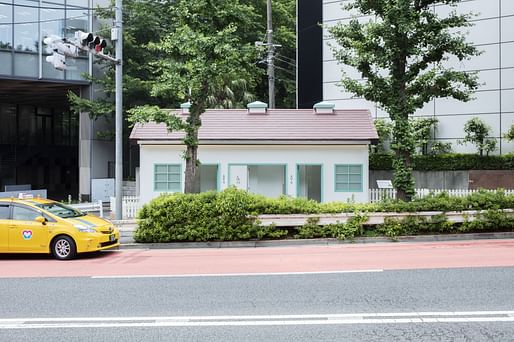

Japanese fashion designer Nigo, the man behind the popular clothing brand, A Bathing Ape, has designed a public toilet that takes the shape of a small home as part of the Tokyo Toilet project.
The toilet is located in the Harajuku district within central Tokyo, which is the region of the city that Nigo is originally from. Modest and dainty, it was envisioned to starkly contrast the surrounding high-rise, urban environment.
“First and foremost, I thought about its accessibility and ease of use,” said Nigo. “In contrast to the ever-changing city of Tokyo with its sky-high buildings, I envisioned a toilet that feels like a good old home that stands quietly on a corner of Harajuku. The toilet may feel nostalgic to some and new to others, depending on their age and generation.”
The inspiration for the toilet’s design derives from the Washington Heights Dependent Housing complex, which was a large housing development built in the area by United States Armed Forces in 1946 following World War II. As explained by Nigo, the central design concept for the project is about learning from the past, so the toilet serves to preserve a fading, historic structure.
“Washington Heights had a significant impact on Harajuku’s growth into the cultural town it is today, and Dependent Housing greatly influenced the post-war lifestyle changes in Tokyo,” explained Nigo.
Close attention was paid to its details, such as the rustic garden fence and the inward-opening door, to create a warm, casual, and inviting “home.”
“I also carefully considered the hygienic aspects of the facility by providing ample washing space and installing contactless faucets and fixtures,” Nigo continued. “I consider public restrooms to be places where people of the community help and support each other. I hope that the people of this town will use this toilet and keep it clean and beautiful, forever.”
The Tokyo Toilet project is an initiative started by the Nippon Foundation and the Shibuya City government that has invited 16 creators to design public toilets in 17 locations across Tokyo’s Shibuya area. Along with Nigo, some participants include Pritzker Prize-winning architects Tadao Ando, Shigeru Ban, Toyo Ito, and Fumihiko Maki, along with fellow Japanese architects Sou Fujimoto and Kengo Kuma. So far, nine of the toilets have been completed, with the remainder set for completion through 2021.
1 Comment
Looks like the public toilets you find in the east bay.
Block this user
Are you sure you want to block this user and hide all related comments throughout the site?
Archinect
This is your first comment on Archinect. Your comment will be visible once approved.